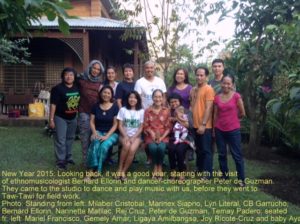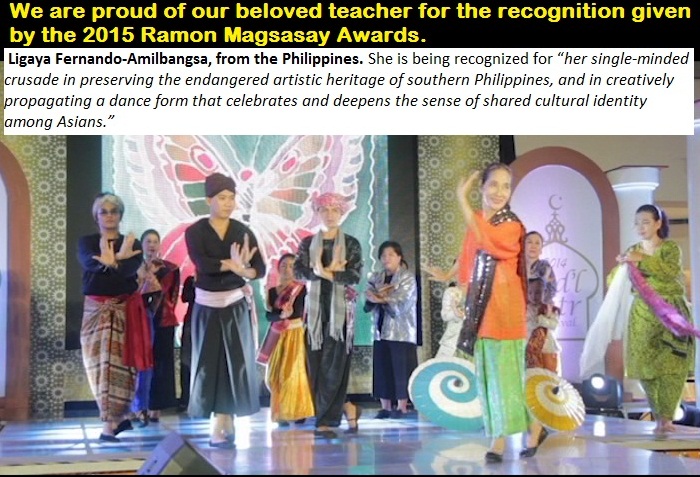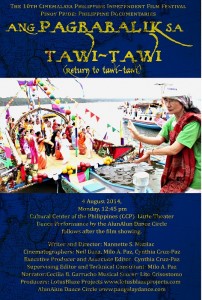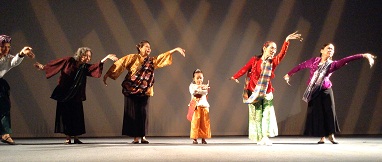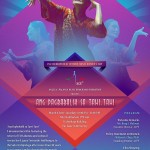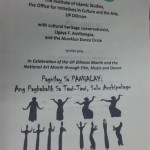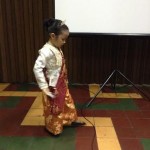![SEPTEMBER [LFA receives lifetime achievement award]](http://pangalaydance.com/wordpress/wp-content/uploads/2016/05/SEPTEMBER-LFA-receives-lifetime-achievement-award.png)
BONGAO, Tawi-Tawi- On Sept. 25, 2015, the provincial government of Tawi-Tawi again recognized the contribution of Ms. Ligaya Fernando-Amilbangsa to the preservation of the rich cultural heritage of the province during the Agal-Agal Festival program held at the DepEd Compound as part of its 2nd annual Kamahardikaan celebration.
Immediately before the awarding, Dr. Filemon G. Romero, Chairman of the Agal-Agal Festival Committee, read Resolution No. 19 s. 2015which granted Ms. Amilbangsa the Life Achievement Award as a Tawi-Tawian. The resolution stated that Ms. Amilbangsa is “considered a Tawi-Tawian,” due to her marrying Datu Punjungan Amilbangsa and her having lived a major portion of her life in Sitangkai, Simunul, and Bongao. It also recalled that in 2011, she was awarded the Most Outstanding Tawi-Tawian in the field of culture and arts due to her contribution in the preservation of the rich cultural heritage of the province as the founder of MSU TCTO Tambuli Cultural Troupe, which still continues to preserve the authenticity of the native dances and music of Sulu and Tawi-Tawi.
The resolution also mentioned her authoring two books: Pangalay: Traditional Dances and Related Folk Artistic Expressions, and Ukkil: the Visual Arts of the Sulu Archipelago, as well as her developing a dance vocabulary and methodology to teach Pangalay to non-native dancers. Finally, the resolution also cited Ms. Amilbangsa’s having received a Ramon Magsaysay Award in 2015.
Officials from the different towns of the province looked on as Ms. Amilbangsa was conferred the “Lifetime Achievement Award to a Tawi-Tawian.” Ms. Amilbangsa graciously accepted the award with a speech amid a colorful sea of dancers and boat-inspired floats.
After the awarding ceremonies, participating municipalities showcased the rich cultural traditions of Tawi-Tawi through their dance showdown pieces highlighting different aspects of their culture, as well as the important role of the Agal-agal (seaweed) industry. Among the board of judges for the street dance competition and dance showdown were Ms. Amilbangsa’s former and present Pangalay dancers: Hja. Sakinur-Ain Delasas, who is now the Artistic Director of the Tambuli Cultural Troupe; Mahail Hadjan, who founded another cultural troupe, the Jama Sambatau; and Louanne Mae Calipayan, who is with Ms Amilbangsa’s Manila-based group, the AlunAlun Dance Circle.
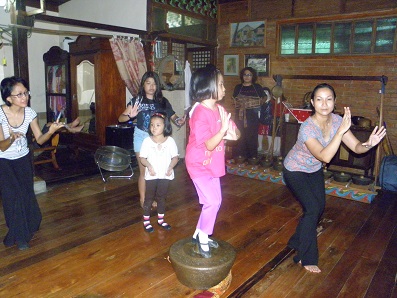
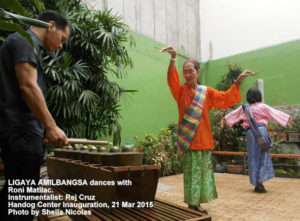
 On 20 and 21 March 2015, the Handog Center was inaugurated with film showings on the first day and performances on the second day. The Handog Center is another home of the AlunAlun Dance Circle based in Marikina City, with address at 9 JP Rizal corner MH del Pilar streets, Calumpang, Marikina City. The Handog Center is the present (2016) address and office of the AlunAlun Dance Circle.
On 20 and 21 March 2015, the Handog Center was inaugurated with film showings on the first day and performances on the second day. The Handog Center is another home of the AlunAlun Dance Circle based in Marikina City, with address at 9 JP Rizal corner MH del Pilar streets, Calumpang, Marikina City. The Handog Center is the present (2016) address and office of the AlunAlun Dance Circle. 


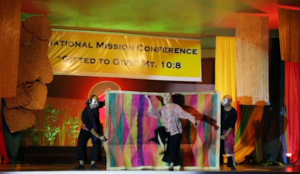
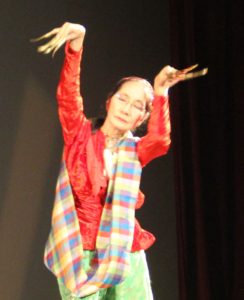 The well-deserved award for Ms. Ligaya Amilbangsa, ADC artistic director, is recognition of her quiet and continuous efforts in preserving intangible cultural heritage. This iconic photo is by Isa Lorenzo.
The well-deserved award for Ms. Ligaya Amilbangsa, ADC artistic director, is recognition of her quiet and continuous efforts in preserving intangible cultural heritage. This iconic photo is by Isa Lorenzo.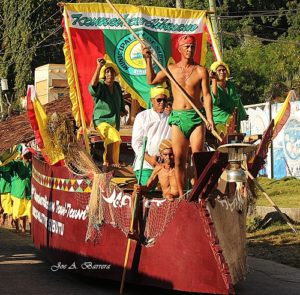 Tawi-Tawi was the original place where Ligaya Amilbangsa started her research on pangalay since the 1960s. The link to the province has grown even stronger in the 21st century. In September 2015, Ligaya Amilbangsa and Louanne Mae Calipayan graced the 42nd Kamahardikaan Festival as judges in the Agal-Agal Festival. (See separate article by Louanne Mae Calipayan.)
Tawi-Tawi was the original place where Ligaya Amilbangsa started her research on pangalay since the 1960s. The link to the province has grown even stronger in the 21st century. In September 2015, Ligaya Amilbangsa and Louanne Mae Calipayan graced the 42nd Kamahardikaan Festival as judges in the Agal-Agal Festival. (See separate article by Louanne Mae Calipayan.) On a sultry afternoon on 10 October 2015, the ADC presented a dazzling 20-minute open air performance. This was on the occasion of the 75 th Anniversary of the founding of Quezon City. The performance preceded the street dancing competition.
On a sultry afternoon on 10 October 2015, the ADC presented a dazzling 20-minute open air performance. This was on the occasion of the 75 th Anniversary of the founding of Quezon City. The performance preceded the street dancing competition. On 14 October 2015, the ADC led by Ligaya Amilbangsa conducted a lecture with dance demonstration for the members of the Museum Volunteers of the Philippines (MVP) for their Philippine history course. The lecture demo was held at the amphitheater of the Ateneo Professional Schools, Rockwell Center, Makati City. The activity signaled the start of a fruitful relationship with the MVP in 2016.
On 14 October 2015, the ADC led by Ligaya Amilbangsa conducted a lecture with dance demonstration for the members of the Museum Volunteers of the Philippines (MVP) for their Philippine history course. The lecture demo was held at the amphitheater of the Ateneo Professional Schools, Rockwell Center, Makati City. The activity signaled the start of a fruitful relationship with the MVP in 2016.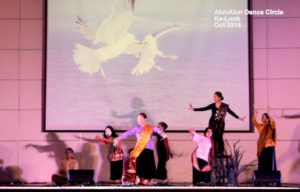
![SEPTEMBER 2015 TWT [LFA with group at airport]](http://pangalaydance.com/wordpress/wp-content/uploads/2016/05/SEPTEMBER-2015-TWT-LFA-with-group-at-airport-300x225.jpg)
